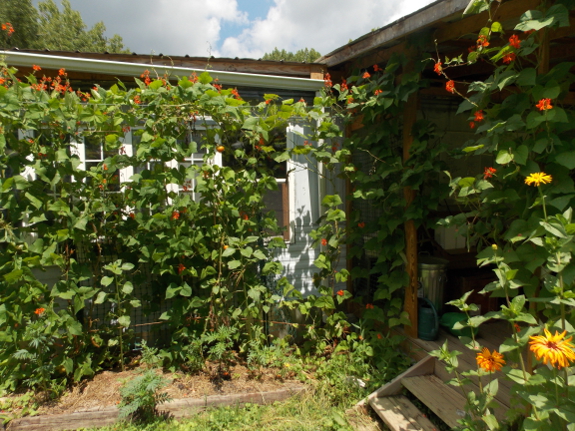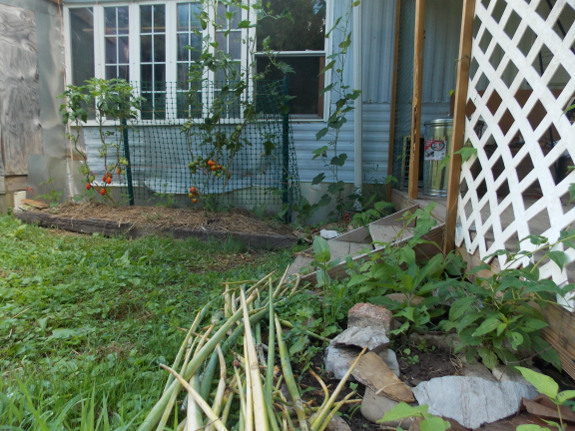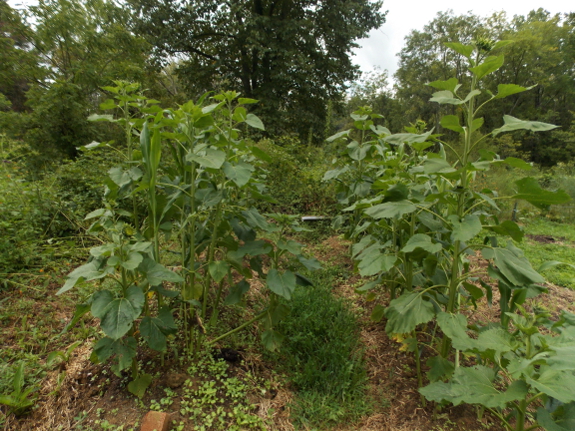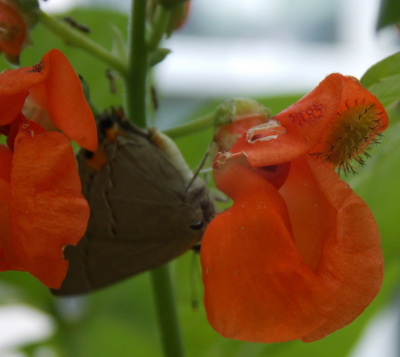
Scarlet runner beans

I'm intrigued by the potential of the scarlet runner beans I'm growing for the first time this year. I planted them for quick shade along the south face of the trailer
while the perennial vines get established, but I was soon taken by the
way the orange-red flowers attract hummingbirds (plus bumblebees,
butterflies, and other insects). And now I'm wondering whether
biomass production might not really be scarlet runner beans' primary
selling point.
 "Those
plants are like annual kudzu!" I told Mark at lunch yesterday, and he
asked me why I was being so mean to the beans. But, the truth is, I
was paying them a compliment. If the species wasn't the scourge
of the South, kudzu would have a lot going for it from a permaculture
perspective due to its ability to fix nitrogen, to thrive in poor soil,
and to grow extremely quickly. Scarlet runner beans seem to share
many of the same traits, as you can see by comparing the two photos
above --- the top picture was taken this weekend while the second photo
is from only seven weeks earlier. Since scarlet runner beans are
annuals instead of perennials, they can put out this crazy amount of
weekly growth with much less risk of the beans taking over the world.
"Those
plants are like annual kudzu!" I told Mark at lunch yesterday, and he
asked me why I was being so mean to the beans. But, the truth is, I
was paying them a compliment. If the species wasn't the scourge
of the South, kudzu would have a lot going for it from a permaculture
perspective due to its ability to fix nitrogen, to thrive in poor soil,
and to grow extremely quickly. Scarlet runner beans seem to share
many of the same traits, as you can see by comparing the two photos
above --- the top picture was taken this weekend while the second photo
is from only seven weeks earlier. Since scarlet runner beans are
annuals instead of perennials, they can put out this crazy amount of
weekly growth with much less risk of the beans taking over the world.

Since our soil is getting
richer by the year, meaning we can grow more food in less space, I've
been tossing around ideas for what to do with the freed up growing
room. One big goal is to grow more of our own compost and
mulch. To that end, I'm experimenting with some plants that I
wouldn't quite call cover crops since they don't out-compete weeds, but which might mix together to make a prime compost pile.
 The
photo above shows this summer's experiment of sunflowers and sorghum,
with oilseed radish planted around the roots of the left-hand bed for
weed control. Perhaps the relatively woody stems of sunflowers
will combine with the high-nitrogen vines of scarlet runner beans to
create good compost? As a lazy gardener, I'd love it if the
compost could be made in place --- just toss the plant carcasses on top
of a garden bed in the fall and let them rot into compost by spring
while shading out weeds in the process.
The
photo above shows this summer's experiment of sunflowers and sorghum,
with oilseed radish planted around the roots of the left-hand bed for
weed control. Perhaps the relatively woody stems of sunflowers
will combine with the high-nitrogen vines of scarlet runner beans to
create good compost? As a lazy gardener, I'd love it if the
compost could be made in place --- just toss the plant carcasses on top
of a garden bed in the fall and let them rot into compost by spring
while shading out weeds in the process.
It seems like I've always
got exciting cover crop experiments in the works. That's the sign
of a geeky gardener --- she's drawn to the buckwheat being grown for
soil improvement before she takes a look at your tomatoes.
Want more in-depth information? Browse through our books.
Or explore more posts by date or by subject.
About us: Anna Hess and Mark Hamilton spent over a decade living self-sufficiently in the mountains of Virginia before moving north to start over from scratch in the foothills of Ohio. They've experimented with permaculture, no-till gardening, trailersteading, home-based microbusinesses and much more, writing about their adventures in both blogs and books.
Want to be notified when new comments are posted on this page? Click on the RSS button after you add a comment to subscribe to the comment feed, or simply check the box beside "email replies to me" while writing your comment.

"Tithonia Diversifolia. A beautiful perennial plant that will reach 10-15(up to 20 at times) feet tall. It has large dark leaves and throughout the cool months produces masses of large yellow "sunflowers" that smell like honey. Its a must have for any gardener; it makes a beautiful hedge or wind break. It grows very fast. It also makes a very good mulch for garden beds. Use it as fodder for livestock, or the leaves for chickens too. Its highly nutritious. The flowers can be made into a tea as well. Plants are sterile so they wont seed everywhere."
I grow this here in Florida. I don't know if you've heard of it. It is a sub, tropical plant, but it grows so fast. You could keep small plants going in wither inside then plant out and still get what you want for mulch and compost. I cut it back by 2-3 feet every month in summer for my goats to eat. Nothing bothers it either. Which is a huge plus here in FL, and the south. If you're interested, I do sell cuttings.
Roland --- I wish I could capture what it feels like to look out the window into the jungle of foliage and flowers (and hummingbirds). Definitely the highlight of my summer.
T --- Intriguing! I'm less keen on things I have to grow from cuttings, since that means extra work keeping them alive over the winter. But I might experiment with some this coming summer. Do you have a website? How should folks contact you if they want to buy cuttings?
It does very well from cuttings. You just take a stick of it and poke it in the ground. Imo it's very much worth it. I just started growing it last year and I have grown tons, yes tons, of biomass. In just two summers. It's now my main plant for building up my sand, and feeding the animals.
The site is tefoe.com, It's under work atm. But anyone can contact me at T.FLfarms@yahoo for the moment.
If you'd like Anna, shoot me an email, I don't know if I still have your address written down somewhere, and I can send you a few now. I'd like to know if you think they'd be too much work after trying them. I think that they might do well in one of your damp areas. They can take the dry, but well watered, mine have grown more than I can use at times.
Love the red runners, hammers too. 5bzone and always an annual. Beans are very tasty when young Love the site keep on trucking Al
I'm experimenting with scarlet runners this year, too. I'm interested in getting more color in my garden without sacrificing food production. Seems to be working, we'll see how the dilly beans turn out.
On the subject of kudzu, I've heard that they are related to peas (hence nitrogen fixing) and are actually edible. Being from the North, I couldn't immediately run out and try it but it's on my bucket list.
I think you're mistaken - Scarlet Runners are, like other runner beans, perennial. As another commenter pointed out, they die back to tubers. At this point you can transplant the tubers to a different spot. But I just cut back the dead plants and put a few sticks in the ground to remind me that there's something there. This year I'm experimenting with another runner bean, the Greek Gigante bean - they look like enormous white lima beans. The flowers are creamy white, but the hummers seem to go after them just as eagerly as they go after the scarlet runners.
The best bean for the money, you can eat them 3 ways.
The pretty red flowers are great in salads. Cook and eat the 'string bean'. Or let the beans dry on the vine for 'dryed beans' for soups. That is whY the Pioneer's took them out west on the wagon trains. Don't forget to save some dryed seed for next year! And don't leave ANY on the ground over winter or they will come up EVERYWHERE.